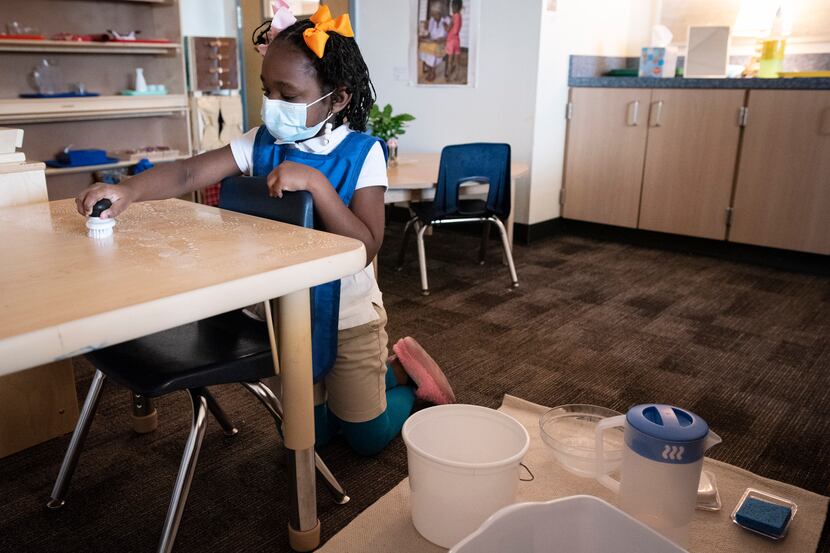Mirabor Ofugara sat cross-legged on the floor of her Montessori classroom, considering a laminated card with a chocolate chip cookie on it. Was it living or non-living, the 4-year-old asked herself.
Ofugara reasoned that she, a living being, often ate cookies, but she had never seen a cookie eat anything. A cookie was not alive, she declared, before placing it in a pile of cards of other non-living things.
As Ofugara sorted the peanut butter sandwiches and chocolate chip cookies from the trees and turtles, her peers in Lake Ridge Elementary’s Montessori classroom tended to their own activities. Some built towers with bright pink blocks, while others used beads to learn counting skills. All the children wore masks and sat several feet apart, taking cleaning wipes to their projects when they were done.
The Montessori method is known for its emphasis on hands-on learning and student-led activities. It rarely uses technology and encourages teachers to closely observe students’ progress and craft lessons based on individual needs. But all of these values became a challenge to maintain as schools navigate the pandemic.
“To go from a very hands-on, personal type of learning to technology was a big learning curve not only for the students but for the teachers as well,” teacher Sandra Hryekewicz said.
Lake Ridge Elementary is in its second year of offering Montessori education to students. There are now classes for students ages 4 to 12. Parents enroll their children in the program because they say the curriculum allows students to grow into independent thinkers and learn at their own pace.
Many students who were enrolled during the program’s first year got used to the Montessori way, but the pandemic upended their second year. Students saw their specialized education transform from in-person instruction to remote and back again.
In March, when school facilities began to close, teachers were unsure how the Montessori material would shift, Hryekewicz said. It was hard to imagine the lessons could be replicated easily.
Educators everywhere faced a stressful and unprecedented situation. But Montessori teachers had added pressure to uphold their unique learning model through the pandemic, said Mary Caroline Parker, executive director of the Montessori Institute of North Texas.
Parker’s organization, which trains educators on how to carry out the model, brainstormed with teachers on how to best weather the changes for their kids.
“We know that children learn through experiences and interacting with the environment, not listening to a teacher talk, so that makes it really difficult to present online,” Parker said.
At home, the students didn’t have the same access to classroom materials, nor did they get as much personal attention from teachers. And for students who did return to in-person instruction, that was transformed by the pandemic, too.
It became clear to educators that the at-home environment could inform key Montessori lessons. One of the emphasis areas of the curriculum is practical learning, said Lake Ridge teacher Kanetria Doolin.
During a regular school year, for example, students help prepare meals and clean the classroom to develop their motor skills and learn more about practical life. So Doolin asked parents to let kids help with chores and everyday tasks. Students who chose to learn in person could do the same — though they would be required to sanitize the tools they used and clean their workspace frequently. Some of Doolin’s students even helped launder the rags they used for cleaning.
Parent Shema Ross, who has three students enrolled in Lake Ridge’s Montessori program, worked with her three distance learners to make a chore list of what each child could do every day.
“They help with the cleaning, with the cooking, and things outside,” Ross said. “It makes it pretty easy and incorporates that part of Montessori into the home.”
The focus on independent work also translated well to the new learning environment, teachers said. In a typical Montessori classroom, students know the tasks they have to complete by a certain time and can set about tackling them as they see fit.
That’s what attracted parent Megan Micheli to Montessori in the first place.
“They can all be working independently on things that they want to do, not just sitting and doing what they had to do because it was time for math or time for science,” Micheli said.
Her two kids learned from home in the springtime and for the first few weeks in the fall. When they started remote class, Micheli tended to watch over her kids in the day and remind them of their assignments. But after realizing that she could apply the Montessori value of independence, she switched tactics.
She chose to create an environment that gave them all the resources they needed and allowed them to take breaks as they wanted. When Micheli gave her kids more freedom, they still stayed on task, but reordered their day to focus on the subjects they liked best.
Some Montessori values were more challenging to shift. The curriculum leans heavily on specially designed resources. Students become familiar with counting beads to learn numbers, intentionally designed building blocks to grasp space and volume, and cards that explain more difficult concepts like botany.
Hryekewicz used a document camera to display what materials she could to her distance learners. Some parents, like Micheli, printed them off to create their own tools. In the absence of a printer, Doolin encouraged families to get creative with household materials as a substitute for regular classroom fixtures.
For example, Doolin often played a game with her class where she asked students to bring particular objects to her so they could sound them out together and learn about the alphabet.
If she asked for a basket, Doolin would sound out the word with her kids, emphasizing the sounds of the letters b, a, sk and et.
“They’re at home, so they might not have a basket and they may not bring me anything that I have in my room,” Doolin said. “But they might bring me Batman or a fork. We can do that same activity at home.”
The hardest part of the transition to remote learning was the lack of in-person observation, teachers said.
Montessori teachers closely observe their students throughout the day to make individual learning plans for each student. With physical observation out of question for those learning from home, Doolin said, teachers rely on frequent calls and video chats.
In school systems everywhere, there’s immense pressure to make sure students aren’t lagging because of the disruption to the normal learning environment. But when faced with this challenge, Hryekewicz called on yet another Montessori value: self-paced learning.
In the spring, “we picked up immediately, and then we picked up again in the fall,” she said. “We follow the child, wherever the child leaves off.”
The DMN Education Lab deepens the coverage and conversation about urgent education issues critical to the future of North Texas.
The DMN Education Lab is a community-funded journalism initiative, with support from The Beck Group, Bobby and Lottye Lyle, The Communities Foundation of Texas, The Dallas Foundation, Dallas Regional Chamber, Deedie Rose, The Meadows Foundation, Solutions Journalism Network, Southern Methodist University and Todd A. Williams Family Foundation. The Dallas Morning News retains full editorial control of the Education Lab’s journalism.

